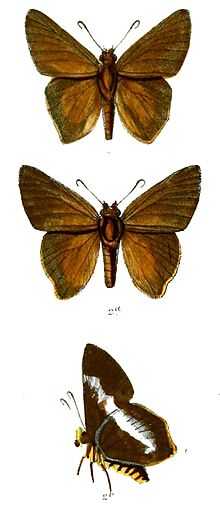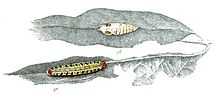Bibasis sena
| Orange-tail Awl | |
|---|---|
 | |
| Male (above), female (middle), male underside (lower) | |
| Scientific classification | |
| Kingdom: | Animalia |
| Phylum: | Arthropoda |
| Class: | Insecta |
| Order: | Lepidoptera |
| Family: | Hesperiidae |
| Genus: | Bibasis |
| Species: | B. sena |
| Binomial name | |
| Bibasis sena (Moore, 1865)[1] | |
Bibasis sena, commonly known as the Orange-tailed Awl, is a butterfly belonging to the family Hesperiidae.[2] It is also sometimes called the Pale Green Awlet though the latter name properly refers to Bibasis gomata.
Distribution
The skipper is found in Sri Lanka, India, Myanmar, Thailand, Laos, south Vietnam, Hainan, Malay peninsula, Indonesian archipelago (including Borneo, Java, Kangean, Bali, Lombok, Bawean, Sumba, Sumbawa) and the Philippines.[2]
In India, the skipper is found in the Western Ghats including the Nilgiris, Kodagu, Kanara, and the Himalayas, from Shimla eastward to Northeast India and onto Myanmar (recorded in the Karens and Dawnas).[3][4]
The type locality for this species is Bengal.[2]
Status
Evans (1932) records the Orange-tail Awl as 'Rare' in India and 'Very Rare' in the Andaman islands. He records the butterfly as 'Not Rare' in South Myanmar, the Malay peninsula and parts of the Indonesian archipelago.[4]
Description
- See glossary for terms used.
Both sexes: The butterfly has a wingspan of 45 to 50 mm.[4] Above, both sexes are an unblemished dark-brown. The hindwing has an orange fringe.The abdomen is orange towards the rear of the butterfly. Below, the wings have white patches; the forewing having a large white central patch, and the hindwing having a broad pure white discal band.[3]
The male has no brands.[3]
Detailed description
Watson (1891) gives a detailed description as follows:-[5]
- Male. Upperside dark chocolate brown. Cilia of hindwing carmine-red. Underside maroon brown ; forewing with a large buff-white patch from the middle of posterior margin, bordered above with purple ; hindwing with a broad transverse purple white band terminating before the anal angle, the inner border of which is sharply defined, the outer suffusing itself on the disk. Cilia carmine-red. Palpi and thorax in front, beneath and anal tuft dull yellow. Thorax beneath greyish brown.
- The female is described by Mr. Moore in his "Lepidoptera of Ceylon" as not differing from the male.
Taxonomy
The skipper has the following subspecies:
- B. sena sena (Moore, 1865) - Type locality: Bengal. Distribution: Sri Lanka, S.India - Burma, Thailand, Laos, Hainan, Andamans.[2]
- B. sena uniformis Elwes & Edwards 1897 - Type locality: Java. Distribution: Burma, Thailand, Malay Peninsula, Borneo, Java, Kangean, Bali, Lombok, Bawean, Sumba, Sumbawa.[2]
- B. sena palawan (Staudinger, 1889) - Type locality: Palawan. Distribution: Calamian Islands, Cebu, Homonhon, Leyte, Luzon, Marinduque, Mindanao, Negros, Palawan, Panay, Polillo, Sibutu, Sibuyan, Tawitawi.
Habits

Diurnal.[6] The butterfly is confined to heavy jungle of low elevations, typically up to 4000 to 5000 ft. The male can be seen in the early mornings, basking on the top of leaves in forest glades and hilltops, chasing off intruders. The typical resting position of the Orange-tail Awl is the underside of the leaf. He does not mud-puddle or visit flowers. The female is usually found close to the host-plants.[3]
Life cycle
The larva has been recorded on Combretum latifolium[2] and Combretum extensum in Kanara.[3] In Andaman the larvae had been recorded on Hiptage benghalensis (Malpighiaceae).[7]
Cited references
- ↑ Card for Bibasis sena in LepIndex. Accessed 16 October 2007.
- ↑ 2.0 2.1 2.2 2.3 2.4 2.5 Marrku Savela's Website on Lepidoptera Page on Bibasis genus.
- ↑ 3.0 3.1 3.2 3.3 3.4 Wynter-Blyth, M.A. (1957) Butterflies of the Indian Region, pg 469 to 479.
- ↑ 4.0 4.1 4.2 Evans,W.H.(1932) The Identification of Indian Butterflies, ser no I3.1, pp 319-320.
- ↑ Watson, E. Y. (1891).
- ↑ Vane-Wright and de Jong (2003) (see TOL web pages on genus Bibasis genus Burara in the Tree of Life Web Project) state that Bibasis contains just three diurnal species, of which sena continues to remain in Bibasis due to its diurnal activity, while the crepuscular remainder having been removed to Burara. The species now shifted to Burara are morphologically and behaviorally distinct from Bibasis, within which many authors have formerly included them.
- ↑ nhm.ac.uk Caterpillar Host plant database
References
- Evans, W.H. (1932) The Identification of Indian Butterflies. 2nd Ed, (i to x, pp454, Plates I to XXXII), Bombay Natural History Society, Mumbai, India.
- Kunte, Krushnamegh. (2000) Butterflies of Peninsular India, (i to xviii, pp254, Plates 1 to 32) Universities Press (India) Ltd, Hyderabad (reprint 2006). ISBN 81-7371-354-5.
- Watson, E. Y. (1891) Hesperiidae indicae. Vest and Co. Madras.
- Wynter-Blyth, M.A. (1957) Butterflies of the Indian Region, Bombay Natural History Society, Mumbai, India.
Online
- Beccaloni, G. W., Scoble, M. J., Robinson, G. S. & Pitkin, B. (Editors). 2003. The Global Lepidoptera Names Index (LepIndex). World Wide Web electronic publication. (accessed 22 September 2007).
- Brower, Andrew V. Z. and Warren, Andrew, (2007). Coeliadinae Evans 1937. Version 21 February 2007 (temporary). http://tolweb.org/Coeliadinae/12150/2007.02.21 in The Tree of Life Web Project, http://tolweb.org/
- Savela, Marrku Website on Lepidoptera (accessed 22 September 2007)